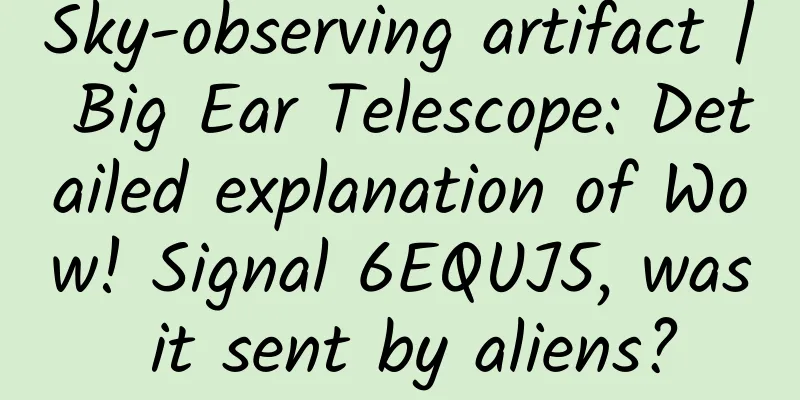Sky-observing artifact | Big Ear Telescope: Detailed explanation of Wow! Signal 6EQUJ5, was it sent by aliens?

|
Author: Hatton (student of the Science Voice Knowledge Writing Training Camp) & Wang Jie Jerry Ehman and the Wow! Signal August 19, 1977 might have been just an ordinary, muggy day for many Americans, but it was quite extraordinary for Jerry Ehman[1]. That evening, he finished his work, made a cup of coffee, sat down to relax, picked up a long paper tape filled with data, and began to read it with interest. He was examining the data sent by the Ohio State University radio telescope, the telescope affectionately called "Big Ear". Image: Jerry Ehman (center), source: bigear.org In the 1970s, observation data was not presented on a screen, but printed on long paper tapes. As a volunteer, analyzing the data on paper tapes has become a part of Eman's life. However, in most cases, the characters on the paper tapes are just like the content they present, densely packed but meaningless, with nothing but background noise. Wow! Signal (Source: bigear.org) Eman couldn't remember how many tapes he had seen. Suddenly, a string of characters came into his sight. He opened his eyes wide to confirm what he saw again and couldn't help but exclaimed "WOW!". This paper tape recorded the telescope observation data from three days ago, that is, on August 15. At the 10:16 position, there were six characters - 6EQUJ5. This string of characters was ordinary in the eyes of ordinary people, but it was very unusual in Eman's eyes. He was stunned at the time, and various possibilities were churning in his mind. Among all the ideas, there was one that was the least likely but the most exciting. Eman was a little afraid to amplify this idea, but it kept churning from the depths of his mind and could not be suppressed. So, what does this string of characters mean? Let's first understand the meaning of these characters. Detailed explanation 6EQUJ5 The letters and numbers on the tape actually have only one meaning, which is the strength of the signal. The lowest strength 1 represents background noise, the strength of 10 is represented by the letter A, 11 is represented by B, and so on. The letter Z represents a strength of 35. On the signal tape, signals with an intensity of 5 or above are already very rare. In a sea of numbers 1 and 2, a string of 6EQUJ5 suddenly appeared, which seemed unusually "abrupt." The signal intensity U was 30 standard deviations higher than the background noise, which is also the highest value in the history of observations of the telescope [2]. 6EQUJ5 consists of 6 characters, each representing a duration of 12 seconds, for a total of 72 seconds, but this does not mean that the signal lasted only 72 seconds. The telescope is fixed on the ground and as the earth rotates, it can only monitor a signal from outside the earth for a maximum of 72 seconds. The intensity change of the signal corresponding to this string of characters is a very standard inverted bell shape, which indicates that it should come from outside the earth. 6EQUJ5 signal strength changes (Source: wiki) Another point to note is that the frequency the telescope monitors is 1.42 GHz. This frequency has a special meaning to astronomers. It is an electromagnetic spectrum line generated by the energy level change of neutral hydrogen atoms, so it is called the "hydrogen band" (the wavelength corresponding to this frequency is about 21 cm, so the hydrogen band is also called the 21 cm line). Since hydrogen is the most abundant basic element in the universe, the hydrogen band has a wide range of astronomical applications. Many scientists believe that if an alien civilization tries to contact us, this is one of the most likely interstellar communication frequencies. Eman had imagined countless times what the message from alien civilizations would look like, and the signal in front of Eman was exactly what he imagined. Eman couldn't contain his excitement, and circled the string with trembling hands, and wrote "Wow!" next to it with a red pen. From the moment Eman marked it in red, the "Wow!" signal and the radio telescope ("Big Ear" telescope) at Ohio State University in the United States that discovered it were forever recorded in the history of SETI (Search for Extraterrestrial Intelligence). Photo: Jerry Ehman many years later (Source: setileague.org) The SETI program to search for extraterrestrial civilizations is a reliable way to search for extraterrestrial civilizations by monitoring electromagnetic waves from the universe and discovering signals from intelligent civilizations. In 1959, American physicists Philip Morrison and Giuseppe Cocconi published an article titled "The Exploration of Interstellar Communication" in the journal Nature, proposing that the best frequency for searching for extraterrestrial civilizations is the hydrogen band. The first formal plan in human history to search for extraterrestrial civilizations was organized and implemented by the famous American astronomer Frank Drake (1930-), and was called the "Ozma Project." Picture: Drake One day in April 1960, Drake pointed the National Radio Astronomy Observatory’s new 26-meter diameter telescope at the star Eta Apollo 10 light-years away, using a frequency of 1.42 GHz. Within a few minutes, the device used to record the signal began to frantically scratch on the paper, and the speaker connected to the telescope also emitted a series of sounds. Drake was stunned. Such a strong signal was found at the beginning of the search. Is it that easy to find aliens? Obviously not that simple. Within a few days, the signal was confirmed to come from an airplane. Further investigation later found that this was actually a secret experiment conducted by the military [3]. In a total of 4 months and about 150 hours of intermittent observation, he did not find any valuable signals except the misleading aircraft. Although the first Ozma project did not yield any results, various SETI projects have emerged one after another and have never stopped since then. In 1971, NASA funded a study and produced a report that made many constructive suggestions and recommended the construction of a radio telescope array with 1,500 dish antennas, called the "Cyclops Project", which continued on a small scale until the 1990s. In 1973, Ohio State University in the United States proposed a new SETI plan, which was implemented by the protagonist of today's program, the "Big Ear" radio telescope. Let me first introduce you to this telescope. Why is it called "Big Ear"? After World War II, the civilian use of radar technology led to the vigorous development of radio astronomy. A number of large-aperture radio telescopes have sprung up, including the 76-meter Jodelbank Radio Telescope in the UK, the 64-meter Parkes Radio Telescope in Australia, and the 305-meter Arecibo Telescope in the United States. Compared with them, the radio telescope designed and built by John D. Kraus (1910-2004), an astronomer at Ohio State University, seems very "niche". Unlike other telescopes, which are expensive and technically complex, it adopts a simple but not simple construction idea of spending little money to achieve great things. In 1955, Kraus proposed a novel radio telescope scheme. Unlike traditional radio telescopes, which use rotating parabolic or spherical surfaces as receivers and can point to different directions in the sky, it uses a fixed parabolic reflector as an antenna. This is not only relatively easy to manufacture, but also very cost-effective. Although the parabolic reflector cannot move, another flat reflector that can adjust its direction is enough to allow the telescope to observe the vast sky between 63° north latitude and 36° south latitude as the earth rotates. It achieves the sensitivity equivalent to a 52.5-meter-diameter spherical surface at a very low cost. In order to reduce costs, many tasks in the construction process were completed free of charge by Kraus' students, such as making telescope models, designing the shape of steel beams, welding work, etc. This is why they only spent $250,000 to complete the project [4]. Photo: Klaus The telescope was completed in 1962 and covers an area larger than three football fields. The overall appearance of this telescope is very similar to a bunk bed, consisting of a "bed surface" and two "bed heads". The middle bed surface is 152.4 meters long and 110.4 meters wide. It is a flat surface made of a mixture of aluminum plates and concrete. It is generally white in color. Its main function is to prevent weak signals from being absorbed by the ground. There are two "bed heads" of different heights at both ends of the "bed surface". The taller one is 103.6 meters long and 30.68 meters high, with an inclination of about 45 degrees to the ground, just like many bunk beds have one end tilted for backrests. It is a flat reflector. The lower one is 110.4 meters long and 21.3 meters high, and is a parabolic reflector. The radio signals from space will first reach the flat reflector, then reflect to the parabolic reflector on the opposite side, and then focus to the speaker feed next to it for signal output processing. From a distance, the two huge reflectors look like two human ears, so many people affectionately call it the Big Ear Telescope. Image: Big Ear radio telescope (Source: bigear.org) The industrious "Big Ear" The "Big Ear" telescope was destined to be busy from the moment it was built. At first, its main task was to conduct sky observations in the radio band. In 1970, it published a star catalog containing nearly 20,000 radio sources, about half of which had never been discovered before, and two of them were the most distant celestial bodies known at the time. Since 1973, the Big Ear telescope has devoted most of its time to the search for extraterrestrial civilization signals. There is a big difference between naturally occurring electromagnetic wave signals and artificial electromagnetic wave signals: natural signals generally have a wide frequency range, while artificial signals generally have a narrow frequency range. Searching for extraterrestrial civilization signals often requires collecting information in multiple narrowband frequency bands at the same time. In 1973, the Big Ear telescope used an 8-channel receiver, which was later upgraded to 50 channels, and after the 1990s it was upgraded to 4 million channels [5]. The telescope's long-term observations have provided a continuous flow of data. These automatically generated data need to be observed and analyzed with the naked eye. Often, new data arrives before the old data has time to be analyzed. It is harder to filter useful information from a large amount of data than to find a needle in a haystack. Finding suspicious signals on densely packed paper tapes is a time-consuming, laborious, and eye-straining task, which can easily make people feel frustrated over time. Because everyone understands that they are expecting an event with a very low probability. Therefore, even if you put in 100% effort, there may be no reward at all. Even more regrettable is that since 1972, the National Science Foundation of the United States has cut the budget of the Big Ear, and data analysis has become the biggest bottleneck. However, there are many volunteers serving the Big Ear for free. Jerry Ehman was one of them. He was originally an assistant professor at Ohio State University, but his job was cut when the budget was cut. However, he still worked for Big Ear as a volunteer. On August 19, 1977, when Ehman saw the string of characters, he was so excited that he wrote a big exclamation "Wow!" on the paper tape. Since then, this signal has been called the "Wow!" signal. The "Wow! signal" is strong and narrow in frequency, with an observed frequency of 1.42 GHz, which is consistent with scientists' speculation about signals from extraterrestrial civilizations. It can be basically concluded that it is not from the Earth, not an artificial satellite, and not a natural phenomenon. It comes from the northwest of the Sagittarius M55 globular cluster. So, was the "Wow!" signal a greeting from an alien civilization? Unfortunately, there is still no universally accepted answer to this question. In the following months, Ehman frequently used the "Big Ear" telescope to search for repeated signals in the same direction. From 1987 to 1989, scientists at the Oak Ridge Observatory used the META array to search; in 1995, the 12-meter radio telescope of the National Radio Astronomy Observatory of the United States also sought the answer; in the 21st century, the powerful American Very Large Array (VLA) radio telescope array also conducted multiple observations [6]. Countless scientists and astronomy enthusiasts have made countless attempts at the same frequency and in the same direction, but have never received that high-intensity signal again. There are many hypotheses about the source of the "Wow! signal". For example, Ehman himself once speculated that it was a signal from the Earth that was reflected back by debris in the Earth's low-Earth orbit. But this hypothesis is difficult to establish, because the hydrogen band is an astronomical protection frequency, and the possibility of artificial creation is very low. In addition, calculations do not support the fact that space debris can return such a signal. In 2017, an American astronomer proposed that the signal was generated by the hydrogen cloud of two comets, but this hypothesis was also strongly refuted by other astronomers. In short, so far, we still cannot rule out the hypothesis that the "Wow! signal" may come from extraterrestrial civilizations. However, in astronomical research, for mysterious signals from outside the earth, the explanation of extraterrestrial civilizations can only be ranked last. Although we hope that humans are not orphans in the universe and that Earth civilization is not the only intelligent civilization in the universe, science requires us to use the most rigorous evidence to treat the most surprising conclusions, even if they are the conclusions that every astronomer desires to obtain. Wow! Interestingly, along with the fame of the "Wow! signal", the string of 6EQUJ5 also unexpectedly became popular. It became a symbol with symbolic meaning, the title of a popular song, and one of my commonly used passwords. The Big Ear Telescope has attracted much attention because of the "Wow! Signal", but we should not forget that in every quiet night, it would prick up its ears and listen carefully to the sounds from the universe. As the "telescope with the longest search for extraterrestrial intelligent life" included in the Guinness World Records, it is precisely because of its decades of hard work that it was possible to discover the highlight moment of the "Wow! Signal". In 1998, the Big Ear Telescope was dismantled and the original site was transformed into a golf course and residence, but the "Wow! Signal" and the efforts made by the Big Ear to search for extraterrestrial civilizations will not be forgotten. Although the earth is small and the universe is huge, as long as we try bravely and explore diligently, even if we don’t get the answers we want, we will definitely benefit a lot in the process. Source http://www.bigear.org/Wow30th/wow30th.htm http://bigear.org/6equj5.htm https://bolide.lamost.org/report/rep7.htm http://www.bigear.org/kraus.htm Wu Xinji. The Big Ear Radio Telescope of the United States: A 400-year-old Eye on the Sky, Part 24[J]. Space Exploration, 2004, 02:39-41. https://en.wikipedia.org/wiki/Wow!_signal |
<<: The taste of yerba mate tea, which is both bitter and fragrant, actually comes from horse manure
>>: Do you always get fish bones stuck in your throat? Have you ever eaten fish without bones?
Recommend
Getting started with information flow advertising, what are the dimensions that can be optimized?
With the explosive growth of mobile Internet , th...
This pre-meal step is possible, but not necessary
When dining out, many people are used to boiling ...
How can a newbie quickly become a Vlogger? An OPPO Reno2 phone is enough!
From taking photos to recording videos, mobile ph...
2023: Relive the amazing moments of "the great power's heavy weapon"
C919 "spreads its wings", giant ships g...
5 common techniques and strategies for live streaming traffic generation!
Nowadays, live streaming is imperative to attract...
How to promote to KOL? Here are 3 ways!
Why do KOLs ignore me? How to convince KOL to pro...
Look up and see the king of the sky!
This article is provided by National Forestry and...
How to write good copy? Here’s a [universal little formula] for you!
Although some people say that there is a group of...
Brand marketing innovation methodology!
If we count the new consumer brands that have bec...
Juliang Qianchuan launched a practical training camp for live broadcast room operators to achieve rapid account creation and high production of live broadcast rooms
Juliang Qianchuan launched a practical training c...
Why are operators always blamed when there are problems with WeChat?
Early in the morning of November 11, my circle of...
Is there any conflict between Baidu bidding and Baidu SEO optimization for the same domain name? What kind of conflict is it?
There is no conflict, but it is recommended to us...
With a budget of 150,000 yuan, Qin Plus, AION and Geometry A, which one is the first pure electric car for young people?
With the entry of the new energy vehicle concept,...
iOS 12 foreshadows five future trends for iPhone and iPad worth paying attention to
Apple's iOS 12 operating system has now been ...
Are peanuts harmful or beneficial? How to eat them more healthily?
Peanuts are not unfamiliar to us. They are also k...









